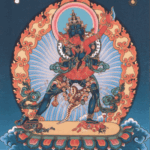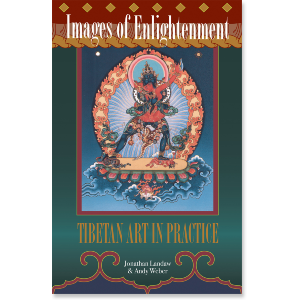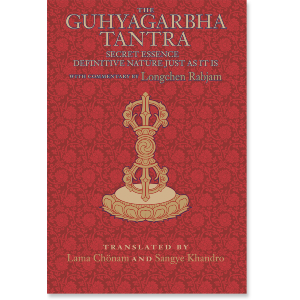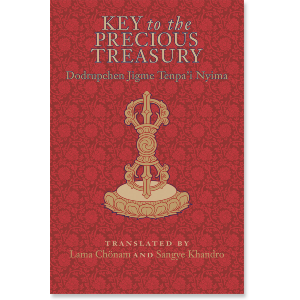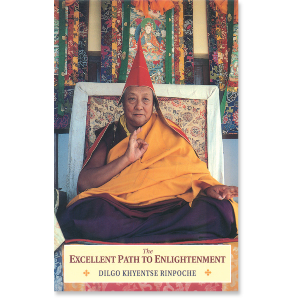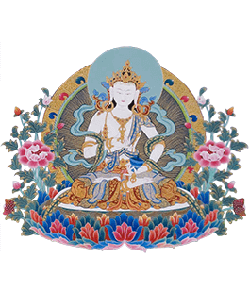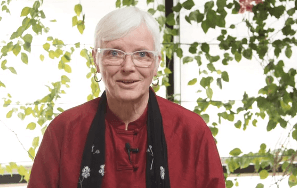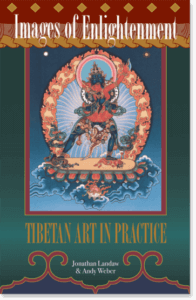
By Jonathan Landaw and Andy Weber
VAJRASATTVA
Vajrasattva the diamond, or adamantine, being is the main deity employed for purification by practitioners of all levels of tantra. Depending on which type of practice is being followed, he can be visualized either alone or with consort.
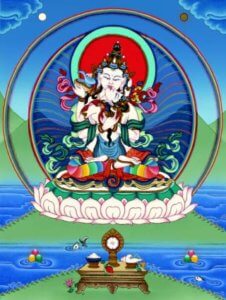
Vajrasattva with consort
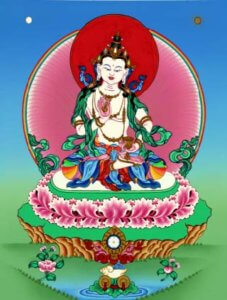
Vajrasattva
Vajrasattva is white in color signifying his immaculate purity. Like Vajradhara, of whom he is an emanation, he holds a vajra symbolizing method in his right hand and the bell of wisdom in his left. Although the solo Vajrasattva is sometimes depicted as sitting with his leg partially outstretched, here he is in the unshakeable full vajra posture. As has been the case with many of the deities presented in this series so far, Vajrasattva wears the beautiful silken garments and jeweled ornaments of ancient Indian royalty.
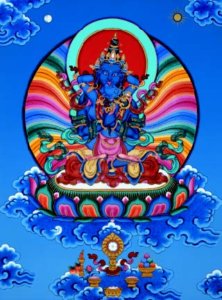
Vajradhara
The techniques of tantric transformation will not be able to produce their profound results as long as our present body, speech and mind remain contaminated by the impurities accumulated from our past unwholesome physical, verbal and mental actions. For our practices to succeed we must not only avoid such unskillful and destructive activities now and in the future, but we must cleanse ourselves of those negative imprints still with us from the past. Vajrasattva meditation is the chief method recommended by the various traditions of Vajrayana Buddhism to accomplish this cleansing, or purification. Furthermore, it is extremely effective for rectifying transgressions of the sacred pledges made by the disciple to the tantric master at the time of empowerment and for restoring whatever tantric commitments we may have broken.
Although a full explanation of the Vajrasattva practice is beyond the scope of this work, a brief indication of what it involves can be given as follows. Above the crown of our head we visualize our root guru in the form of Vajrasattva, having a transparent body of light. At the crown of his head is Akshobhya, the head of the buddha family to which Vajrasattva belongs. At Vajrasattva's heart we visualize the letters of his hundred-syllable mantra standing upright around the edge of a moon disc, in the center of which is the seed-syllable HUM.
Having stabilized this visualization, and entreating our root guru from the depths of our heart to purify all our negative karmic imprints, we recite Vajrasattva's mantra with undistracted concentration. As we do so we visualize cleansing rays of light descending from the HUM and mantra at Vajrasattva's heart, entering us through the crown of our head, purifying us of all defilements and transforming our body into light. At the conclusion of our meditation session we generate the strong feeling that all stains and obscurations have been completely removed. Vajrasattva then dissolves into light and descends into us, becoming indistinguishable from our own body, speech and mind, and we remain for a time in a state of clear awareness without conceptualization.
For this practice to be effective, it is not enough to generate a clear image of the deity and follow the succeeding stages of the visualization practice in their proper order. Without employing what are known as the four powerful opponents, even the clearest visualization will be of little use. First we must generate an honest sense of regret for our past unwholesome actions and transgressions of our sacred word of honor, recognizing their destructive potential. Then we must vow to turn away from committing all such negativities in the future. Thirdly, we invoke the power of reliance by bringing to mind both our refuge in the Three Jewels of Buddha, Dharma and Sangha and our altruistic bodhichitta motivation. Finally we engage in those remedial actions - in this case the recitation of Vajrasattva's mantra and so forth - that counterbalance, uproot and purify our accumulated obscurations. Only if these four powers of regret, vow, reliance and remedy are strong is it definite that purification will take place.
There are various signs that indicate successful purification of negativities. A number of these occur while we are dreaming, such as fighting and overcoming a person dressed in black, vomiting noxious substances, drinking milk, meeting gurus, receiving visions of meditational deities and the like. If we have such dreams repeatedly, not just once or twice, this is an indication that our practices have been fruitful. But there are more definite signs of success that occur while we are awake. Our physical body may come to feel light and buoyant, we find that our need for sleep has decreased, our thinking will be clearer than before and, most importantly, we gain insight into areas of the spiritual path that had previously been obscure. In connection with this last point a contemporary Tibetan master has stated that if we had only an hour in which to study the profound teachings on the Perfection of Wisdom sutras and were to spend the first forty-five minutes engaged in such “collecting and cleansing” techniques as Vajrasattva meditation, we would not be wasting our time in the slightest. Instead, we would be ensuring that whatever study we did in the remainder of the hour would be of maximum benefit.
Although there is a great purpose in performing such preparatory practices as Vajrasattva visualization as part of a daily spiritual routine, Tibetan lamas highly recommend that the serious practitioner engage in prolonged meditational retreats during which the deep experience of these practices can be cultivated. Certain lamas will not give disciples the empowerment of highest yoga tantra deities until they have completed an extensive retreat on all the preliminary practices. In addition to Vajrasattva these include taking refuge and generating bodhichitta, making mandala offerings, cultivating guru-yoga, performing prostrations, and so forth. In one such retreat the disciple may recite the hundred-syllable mantra of Vajrasattva more than one hundred thousand times, and this may be repeated many times during his or her training.
The stipulation that the advanced teachings of highest yoga tantra will not be given unless and until the disciple completes these extensive preliminary practices serves several purposes. It not only weeds out all those whose interest in pursuing tantra is superficial and those who are easily discouraged by hardships, but most importantly it provides those who have the perseverance and dedication to complete these preliminaries with the necessary foundation for their future spiritual growth. It has even been said that for a disciple with the proper qualifications, the goal of enlightenment can be achieved through the practice of these preliminaries alone.

Ushnisha Vijaya "who bestows boundless wisdom and the best of lives."
Those who have completed an extensive retreat of Vajrasattva purification testify from their own experience that their perception of the phenomenal world undergoes a profound change. It is not that the world itself has been transformed but that the meditator’s view of it has been purified. It is as if the doors of perception have been opened wider and subtly obscuring curtains have been drawn back from the windows of the mind. Beings and phenomena take on a pure appearance—a reflection of the practitioner’s own newly revealed purity—and the gravitational field keeping us anchored in ordinary mundane reality is relaxed. Although this exhilarating vision of a world filled with infinite possibilities may fade, it provides a great incentive for pursuing the higher practices and a conviction that full enlightenment, though still a distant goal, is actually attainable.
[Expert from pages 112-119]

